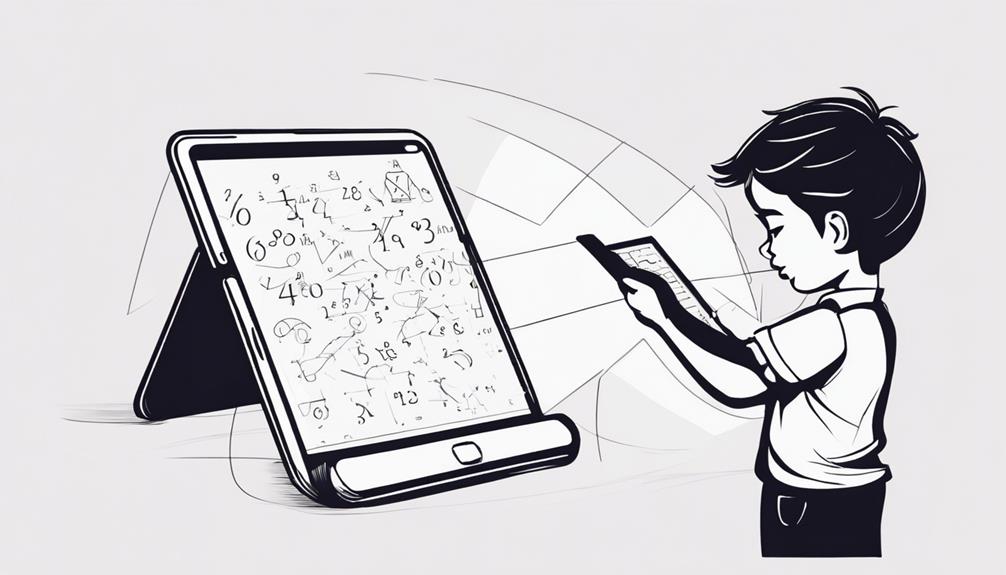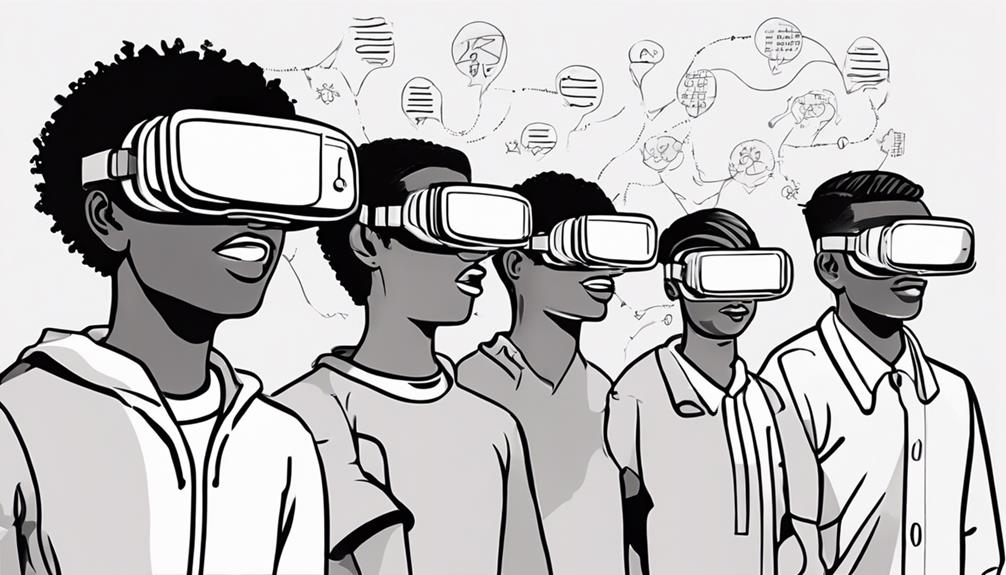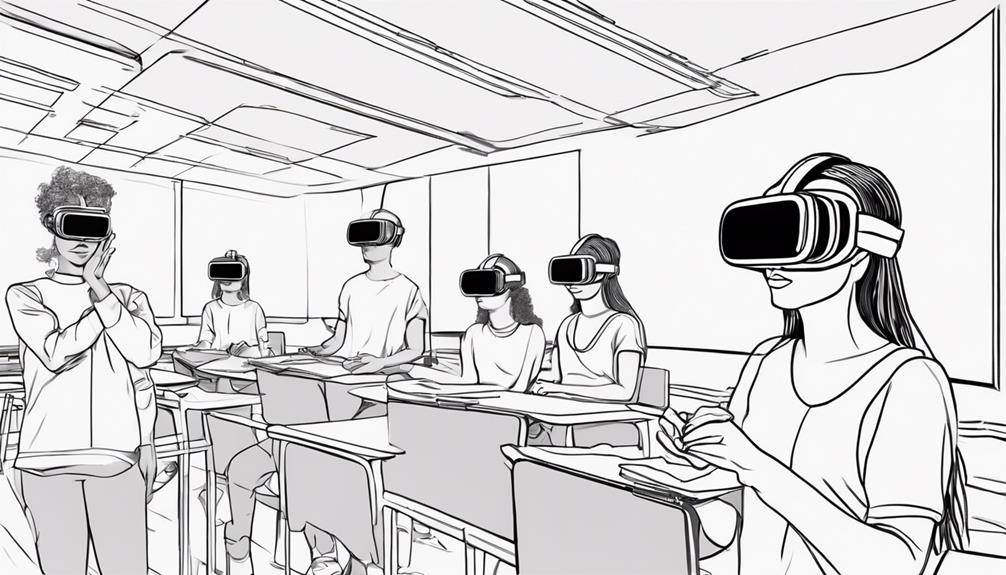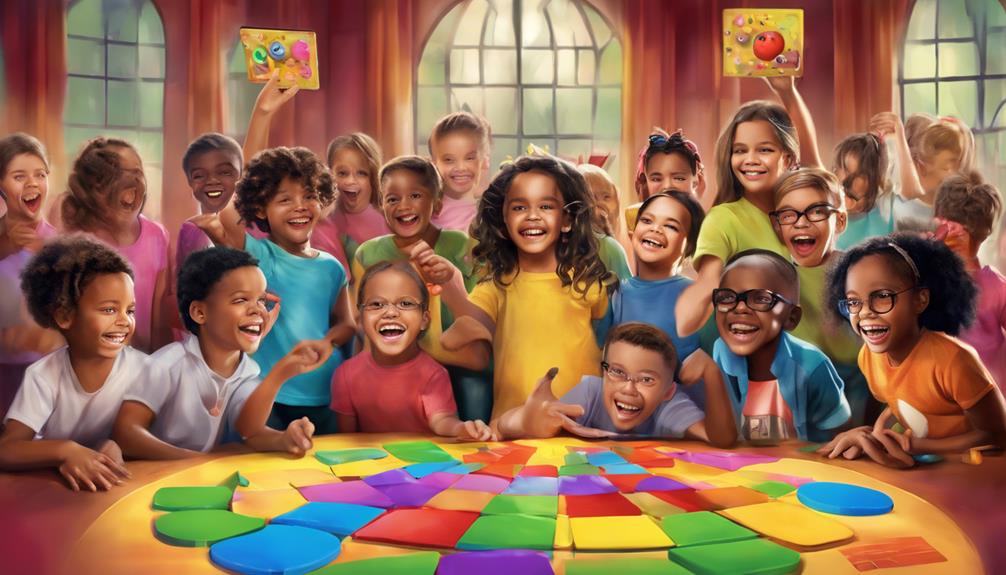Educational games have become a prevalent tool in modern educational settings, but what sets them apart from traditional teaching methods? These games go beyond mere entertainment by strategically integrating educational content with game mechanics to create a dynamic learning experience. From fostering critical thinking to promoting collaboration, educational games offer a myriad of benefits that significantly impact student learning outcomes. But how exactly do these games achieve such results, and what specific strategies make them effective in enhancing student engagement and academic performance?
Key Takeaways
- Educational games merge entertainment and learning, enhancing cognitive skills and critical thinking.
- They boost student engagement, academic performance, and create interactive learning environments.
- Technology integration in games offers real-time feedback, adaptive learning, and personalized experiences.
- Games cater to diverse learning styles, providing personalized, adaptive features for effective skill development.
Definition of Educational Games

Educational games, by definition, are interactive tools specifically crafted for educational purposes to enhance learning outcomes. These games serve as a bridge between entertainment and education, creating an engaging platform for students to acquire knowledge and skills in a fun and interactive manner. Teachers use educational games to supplement traditional teaching methods, making learning more enjoyable and effective. By incorporating educational games into the curriculum, teachers can cater to different learning styles and abilities, ensuring that all students have the opportunity to grasp the material.
These games cover a wide range of subjects and skills, including math, language arts, science, critical thinking, and problem-solving. Through gameplay, students not only improve their retention of information but also enhance their critical thinking skills and academic performance. Research indicates that educational games can increase students' motivation, engagement, and knowledge retention, making them valuable tools in the educational landscape. The interactive nature of these games encourages active participation and fosters a deeper understanding of the material presented.
Types of Educational Games
Educational games encompass a wide range of categories designed to cater to specific learning objectives. Serious games are tailored to focus on targeted educational goals, while simulations offer immersive experiences mirroring real-world situations for enhanced learning. Gamified learning activities integrate game elements to boost engagement and motivation in educational settings.
Game Categories
Categorizing educational games into distinct types enables a more nuanced understanding of their varied purposes and benefits. Simulation games like SimCity and RollerCoaster Tycoon offer real-world scenarios for learning, enhancing decision-making skills. Puzzle games, such as Sudoku and Tetris, focus on problem-solving and critical thinking. Adventure games like Minecraft and The Legend of Zelda provide opportunities for exploration and creativity, fostering imagination and strategic thinking. Quiz games like Kahoot and Quizizz engage students through interactive quizzes and assessments, promoting knowledge retention and quick thinking. Each type of educational game serves a unique purpose in enhancing different skills, making them valuable tools for educators looking to engage students in meaningful and interactive learning experiences.
Learning Objectives
Frequently utilized in educational settings, various types of games serve distinct learning objectives by targeting specific cognitive skills and knowledge acquisition. Educational games encompass a wide range of formats, including simulation games, puzzles, quizzes, and interactive activities, all designed to enhance learning experiences. These games promote active participation, problem-solving, critical thinking, and skill development among players. By engaging in gameplay, learners can enhance their understanding of various concepts while honing their cognitive abilities. Below is a table highlighting the key learning objectives addressed by different types of educational games:
| Learning Objectives | Types of Educational Games |
|---|---|
| Problem Solving | Simulation Games |
| Active Participation | Quizzes |
| Critical Thinking | Puzzles |
| Skill Development | Interactive Activities |
Benefits of Using Educational Games

Enhancing student engagement and motivation, educational games offer a multifaceted approach to fostering critical thinking, problem-solving, and collaboration skills. These benefits of educational games help students in various ways:
- Enhance Learning: Educational games provide an interactive and engaging platform for students to grasp complex concepts. By immersing students in a virtual environment that requires problem-solving and critical thinking, educational games enhance the learning experience.
- Develop Problem-Solving Skills: Through challenging scenarios and puzzles, educational games encourage students to think critically and strategically to overcome obstacles. This process not only sharpens their problem-solving skills but also teaches them how to approach challenges methodically.
- Promote Game-Based Learning: By incorporating educational content into game formats, students can learn and practice new skills in a fun and engaging way. Game-based learning not only captures students' interest but also encourages them to explore and experiment within a safe learning environment.
Impact on Student Engagement
Educational games have a profound impact on student engagement by stimulating learning interest and cultivating active class participation. The interactive nature of these games not only enhances students' motivation but also fosters a focused learning environment. By incorporating engaging themes and fun elements, educational games captivate students' attention, leading to improved outcomes and a deeper retention of information.
Boosting Learning Interest
Through the integration of interactive and engaging elements, educational games effectively arouse students' interest and enhance their active participation in the learning process. This approach helps motivate students to engage with educational content in a more dynamic manner, resulting in increased student engagement and improved learning outcomes. The playful learning environment created by educational games captures students' attention and makes the learning experience more enjoyable and compelling. By incorporating interactive elements, such as quizzes, challenges, and rewards, educational games stimulate students' curiosity and encourage them to explore concepts in a hands-on way.
Key Points:
- Educational games create a dynamic and interactive learning environment.
- Gamified experiences promote active student participation.
- Playful learning elements enhance student interest and motivation.
Enhancing Class Participation
Integrating interactive educational games into classroom settings cultivates a vibrant learning atmosphere that actively involves students and enhances their overall engagement in academic activities. By incorporating interactive elements, these games promote class participation, encouraging students to interact with the material in a dynamic way. This active involvement fosters a positive learning environment where students are motivated to participate and learn. Research indicates that using educational games boosts student engagement, leading to improved academic performance. The interactive nature of these games captures students' interest, encouraging them to be more attentive and participative in class activities. Overall, integrating educational games into the classroom setting enhances student engagement, creating a more interactive and effective learning environment.
Role in Skill Development

Playing educational games contributes significantly to the development of various skills in individuals, offering interactive challenges and puzzles that enhance problem-solving abilities. These games play a crucial role in fostering cognitive skill development, problem-solving skills, social interaction, language development, and critical thinking. Here are three key ways in which educational games help in skill development:
- Problem-Solving Skills: Educational games present players with complex problems and puzzles that require creative thinking and logical reasoning to solve. By engaging with these challenges, individuals enhance their ability to analyze situations, strategize solutions, and overcome obstacles effectively.
- Language Development: Many educational games incorporate vocabulary-building activities and communication exercises, which help improve language skills. By interacting with game characters, reading instructions, and following storylines, players can enhance their linguistic abilities and expand their vocabulary.
- Critical Thinking: Educational games often present players with scenarios that require critical decision-making. By navigating through these scenarios, individuals are encouraged to think critically, evaluate options, and make informed choices, thereby honing their critical thinking skills.
Incorporating Educational Games in Curriculum
The integration of educational games into the curriculum presents an opportunity to enhance learning outcomes and effectively engage students. By providing interactive and hands-on experiences, these games make learning more enjoyable and memorable, catering to diverse learning styles and preferences among students. Utilizing educational games for formative assessment, pre-assessment, or review purposes allows teachers to gauge student understanding and progress while fostering critical thinking and problem-solving skills in a dynamic learning environment.
Enhanced Learning Through Games
Utilizing educational games within the curriculum enhances learning outcomes by fostering interactive and engaging experiences that promote information retention and practical application of concepts. Educational games offer numerous benefits for students, including:
- Enhanced Learning Potential: Educational games tap into different learning styles, making the learning process more effective and enjoyable for students.
- Formative Assessment: Games provide immediate feedback, enabling teachers to assess student understanding in real-time and address any misconceptions promptly.
- Social-Emotional Learning: Incorporating games in the curriculum promotes collaboration, critical thinking, and problem-solving skills, fostering social-emotional development in students.
Engaging Students Effectively
Incorporating educational games in the curriculum facilitates a dynamic and interactive learning environment that enhances student engagement and promotes effective knowledge acquisition. These gamified learning experiences have been shown to significantly increase student motivation and active participation in classroom activities. By integrating educational games into the curriculum, students are more likely to stay focused and interested in the lesson content, leading to a positive learning environment where they are more engaged and enthusiastic about the subject matter. Moreover, when used effectively, games can improve student outcomes and achievement levels by providing a hands-on approach to learning that complements traditional teaching methods. Overall, incorporating educational games in the curriculum is a powerful tool for engaging students effectively and enhancing the learning experience.
Enhancing Learning Outcomes

Enhancing learning outcomes through the integration of educational games is a proven method to boost student engagement and motivation while fostering critical thinking skills and problem-solving abilities. Educational games offer interactive and experiential learning opportunities, providing a platform for students to apply theoretical knowledge in practical scenarios. This approach not only enhances understanding but also encourages active participation and collaboration among students. By immersing learners in a gaming environment, teachers can create a dynamic space where students can explore concepts, experiment with different solutions, and learn from their mistakes in a risk-free setting.
Key Points:
- Increased Engagement: Educational games capture students' interest and maintain their focus throughout the learning process.
- Development of Critical Thinking: These games challenge students to think critically, analyze information, and make informed decisions.
- Enhanced Problem-Solving Skills: By presenting complex problems within a game format, students can enhance their problem-solving abilities through hands-on practice.
Utilizing Technology in Educational Games
The evolution of educational games has been significantly shaped by the integration of technology, revolutionizing the way students engage with learning content and interact within educational environments. Technology integration in educational games not only enhances student engagement and learning outcomes but also creates interactive and immersive learning experiences. Digital tools embedded in educational games cater to diverse learning styles and preferences, making learning more personalized and effective. One of the key advantages of technology in educational games is the provision of real-time feedback, allowing students to monitor their progress instantly and make necessary adjustments. Furthermore, technology enables adaptive learning opportunities, where educational games can dynamically adjust difficulty levels based on individual student performance, ensuring optimal challenge and support. By utilizing technology in educational games, students are not only better prepared for the digital world but also equipped with essential skills for their future careers in an increasingly technology-driven society.
Strategies for Effective Game-Based Learning

Implementing a diverse range of game types in educational settings can optimize learning outcomes and cater to varied learning styles. When incorporating games in the classroom, educators can utilize various strategies to enhance the learning experience:
- Utilize Different Types of Games: Incorporating a mix of simulations, puzzles, quizzes, and other game types can provide students with a well-rounded learning experience that appeals to different learning styles.
- Learning Through Play: Games offer a hands-on approach to learning, allowing students to engage with educational content in a more interactive and immersive way, promoting better retention and understanding.
- Real-World Application: Designing games that simulate real-world scenarios or problems can help students connect theoretical knowledge to practical applications, reinforcing the relevance of the content and enhancing their problem-solving skills.
Addressing Different Learning Styles
Addressing the diverse learning styles present in educational settings is crucial for optimizing student engagement and comprehension. Educational games play a significant role in catering to various learning styles by offering visual, auditory, kinesthetic, and reading/writing activities. These games create a dynamic learning environment that helps students with different preferences to engage effectively. By incorporating multiple intelligences such as logical-mathematical, linguistic, spatial, bodily-kinesthetic, and interpersonal, educational games support varied learning styles. Interactive engagement through challenges, puzzles, simulations, and collaborative tasks within these games allows for personalized learning experiences tailored to individual needs. Additionally, the adaptive features present in educational games ensure that difficulty levels, pacing, and content delivery adapt to suit the cognitive abilities and learning styles of each student.
| Learning Styles | Educational Games Features |
|---|---|
| Visual | Interactive visuals, diagrams, and graphs |
| Auditory | Audio instructions, sound cues, and voiceovers |
| Kinesthetic | Hands-on activities, simulations, and virtual experiments |
Overcoming Challenges With Educational Games

Utilizing educational games strategically can effectively surmount obstacles encountered in the learning process. These games offer interactive and enjoyable experiences that cater to individual learning styles, providing a personalized approach to education. Immediate feedback is a key feature of educational games, enabling students to promptly identify areas for improvement and consolidate their understanding. Active participation is encouraged through game-based learning, fostering engagement and collaboration among students. By actively involving students in the learning process, educational games enhance student motivation, leading to increased interest and enthusiasm for academic subjects. This heightened motivation can translate into improved learning outcomes and academic performance. Overall, the incorporation of educational games addresses various challenges in education by promoting a dynamic and supportive learning environment that caters to the diverse needs of students.
Key Points:
- Educational games offer interactive and enjoyable experiences tailored to individual learning styles.
- Immediate feedback provided by games aids in student progress tracking and misconception correction.
- Active participation in game-based learning enhances student motivation and engagement.
Case Studies on Educational Games
Educational games have been demonstrated through various case studies to significantly enhance student engagement and improve learning outcomes in academic settings. Research findings from these case studies illustrate the effectiveness of educational games in enhancing retention and understanding of academic concepts. Data collected from educational game case studies also indicate a positive impact on student motivation and participation levels. Moreover, case studies highlight the adaptability of educational games across different subjects and age groups, showcasing their versatility in catering to various educational needs.
Real-world examples presented in educational game case studies offer concrete evidence of the practical application and success of gamified learning approaches. These examples not only demonstrate the potential of educational games to make learning more engaging and effective but also emphasize their ability to foster a deeper understanding of complex topics. Overall, the evidence from case studies supports the integration of educational games as valuable tools in enhancing student learning experiences and achieving positive learning outcomes.
Future Trends in Educational Gaming

What innovations in technology and pedagogy are shaping the landscape of educational gaming for the future? Educational gaming is evolving rapidly, driven by advancements in technology and a deeper understanding of effective pedagogical practices. Here are three key future trends in educational gaming:
- Virtual Reality (VR) and Augmented Reality (AR) Integration: The incorporation of VR and AR technologies is poised to revolutionize educational gaming by providing immersive and interactive learning experiences. These technologies offer students the opportunity to explore virtual worlds, conduct experiments, and engage with educational content in a way that enhances comprehension and retention.
- Personalized Learning Through Adaptive Technology: The future of educational gaming lies in personalized learning experiences tailored to individual student needs. Adaptive technology will enable educational games to adjust difficulty levels, provide targeted feedback, and offer custom learning paths, ensuring that each student receives a personalized and effective educational experience.
- Artificial Intelligence (AI) for Intelligent Tutoring Systems: AI-powered intelligent tutoring systems will play a crucial role in the future of educational gaming by offering students personalized feedback, guidance, and support. These systems will analyze student performance data, identify learning gaps, and provide targeted interventions to enhance learning outcomes.
Frequently Asked Questions
What Is the Purpose of the Educational Games?
The purpose of educational games is multifaceted, encompassing cognitive development, engagement, problem-solving, critical thinking, interactive learning, motivation, memory retention, skill-building, and fun learning. These games provide educational benefits by offering an interactive and engaging platform that enhances learning experiences. By incorporating elements of play into the educational process, students are motivated to participate actively, leading to improved retention of knowledge and the development of essential skills in a dynamic and enjoyable manner.
Do Educational Games Help Students Learn?
Engagement Boost, Cognitive Development, Retention Improvement, Problem Solving Skills, and Fun Learning are hallmarks of educational games. Research supports that these games significantly aid students in the learning process. Through interactive and immersive experiences, students are motivated to participate actively, leading to enhanced retention of information. These games cultivate critical thinking and problem-solving skills, creating a fun and engaging environment that fosters cognitive development.
How Educational Games Improve Learning Skills?
Educational games significantly contribute to cognitive development by enhancing problem-solving skills. They promote critical thinking and decision-making abilities through interactive challenges. Moreover, these games aid in memory retention and improve retention skills by engaging students in various learning activities. The engagement and motivation fostered by educational games facilitate interactive learning and knowledge acquisition, making them effective tools for skill enhancement and academic growth.
What Makes Educational Games Good?
Engaging content in educational games fosters interactive learning experiences. Immediate feedback reinforces critical thinking and problem-solving skills. Well-crafted games challenge students to apply knowledge creatively. These elements collectively contribute to the effectiveness of educational games by enhancing student engagement and promoting deeper understanding of concepts. The blend of interactive features in educational games creates an enriching environment that encourages active participation and meaningful learning outcomes.
Conclusion
In conclusion, educational games serve as effective tools in enhancing student engagement, motivation, and cognitive skills in the classroom. Their ability to cater to different learning styles, promote social and emotional development, and provide a familiar digital environment for learning makes them invaluable assets in education. As we look towards the future, the potential for educational games to revolutionize the way we teach and learn is truly limitless.
